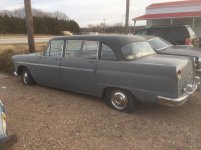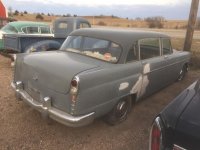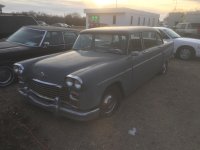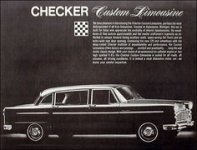You are using an out of date browser. It may not display this or other websites correctly.
You should upgrade or use an alternative browser.
You should upgrade or use an alternative browser.
Checker Custom Limousine
- Thread starter Kurt Arends
- Start date
John ED Renstrom
PCS Member
Now there is o e worth taking home. Did it have the small block Chevy engine in it.
Kurt Arends
PCS Elected Director 2021-2024
6 cylinder. Came out of Dodge City, KS and I could not see any rust, or signs of prior rust repair, on it anywhere. Just some really poor dent repairs on the right side. Interior looked good, but needed the cushions re-done. It has obviously been stored inside. Rare car!
Daniel Scully
PCS Member
1965 Checker Custom Limousine. In South-central Nebraska.
So what makes this a limo? Looks just like a checker to me? Should it have a division window or something else makes it a limo, wheelbase etc? Thanks
Kurt Arends
PCS Elected Director 2021-2024
The lower right photo is a page from their brochure on the Checker Custom Limousine. The rear doors are considerably longer than a standard Checker door. Standard Checkers have, what I call, folding bar stools that flip down for additional passengers. This limousine has regular folding jump seats as you would find in a Cadillac Series 75. This one does not have a partition. It also does have the extended wheelbase.
Otherwise, the interior is just as plain as any other Checker.
Otherwise, the interior is just as plain as any other Checker.
Last edited:
Patrick J. Martin
PCS Life Member/Illini Chapter President
So what makes this a limo? Looks just like a checker to me? Should it have a division window or something else makes it a limo, wheelbase etc? Thanks
At the time of this car's construction and lasting until the end of Checker production, Checker produced what they considered two different model lines, and A-11 and the A-12. The A-11 were cars built for the taxi market, the A-12 were cars named Marathon for the civilian market. Both the A-11 and A-12 were practically identical and rode on a 120 inch wheelbase. These cars could seat eight, three on the front bench seat, three on the rear bench seat, and two on a pair of single-person jumpseats. The jumpseats were angled rather than facing forward in order to give the person in those seats legroom.
Checker also produced the A-11E and A-12E models at the same time. These were essentially the same car but rode on a 129 inch wheelbase. The 'E' in the model designation literally stood for 'extended'. These cars also used 9-inch longer rear doors, so the cars externally continued to look like an ordinary sedan rather than like any type of lengthened car. On the inside, the difference was mainly a two-piece jumpseat that formed a third full-width, forward-facing bench seat giving the cars a nine-passenger capacity.
The E-models, as Checker called them, were available both with and without a divider, making the car available as either a formal limousine or a nine-passenger sedan, but Checker called the E-models limousines whether the car had a divider or not.
Many, but not all, of the civilian market E-models received luxury touches such as plusher interiors, chrome trim, vinyl tops, and Lincoln-like oval quarter windows.
By the mid-1960s, Checker was making active attempts to branch out from their taxis-only image, with the E-models being part of that attempt. Other vehicles that met with varying degrees of success were the Aerobus, Convoy, Medicar, police cars, and station wagons to name a few. Checker even looked into the factory-built ambulance market a couple times, and even built one prototype, a converted station wagon, but ultimately they never attempted that market.
The civilian version of the E-model had some popularity with the US State Department for use at embassies around the world where there was concern that the Cadillac Fleetwood 75 would be too flashy.
John ED Renstrom
PCS Member
one big roomie car just a touch under powered. sounds like a checker.
Bill Marcy
PCS Member
Am I missing something? Is this Checker Limo for sale? Just curious.
Kurt Arends
PCS Elected Director 2021-2024
Yes, it is.
Bill Marcy
PCS Member
Yes, it is.
Thanks Kurt, but I didn't see that info.





